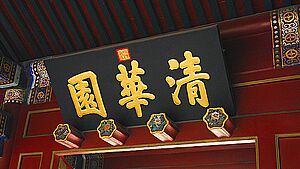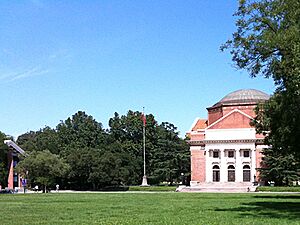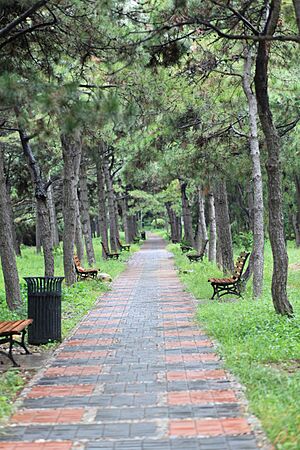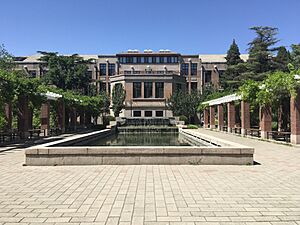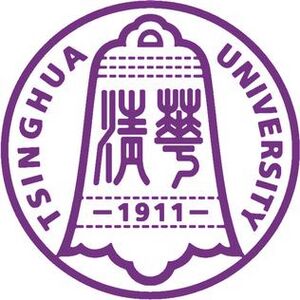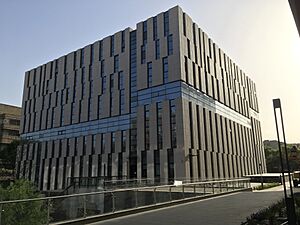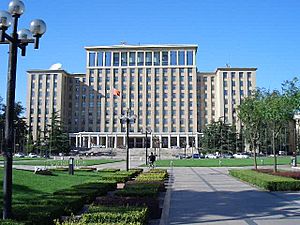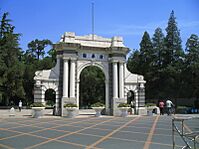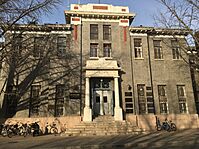Tsinghua University facts for kids
|
清华大学
|
|||||||||||||||||||||||
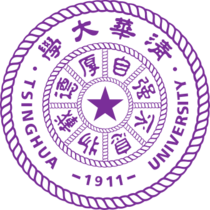
Seal of Tsinghua University
|
|||||||||||||||||||||||
| Motto | 自强不息、厚德载物 | ||||||||||||||||||||||
|---|---|---|---|---|---|---|---|---|---|---|---|---|---|---|---|---|---|---|---|---|---|---|---|
|
Motto in English
|
Self-Discipline and Social Commitment | ||||||||||||||||||||||
| Type | Public | ||||||||||||||||||||||
| Established | 1911 | ||||||||||||||||||||||
| Endowment | ~$6 billion (2023) | ||||||||||||||||||||||
| President | Li Luming | ||||||||||||||||||||||
| Party Secretary | Qiu Yong | ||||||||||||||||||||||
|
Academic staff
|
3,565 | ||||||||||||||||||||||
| Students | 50,390 | ||||||||||||||||||||||
| Undergraduates | 16,030 | ||||||||||||||||||||||
| Postgraduates | 18,610 | ||||||||||||||||||||||
| 15,750 | |||||||||||||||||||||||
| Location |
Haidian, Beijing
,
China
40°00′00″N 116°19′36″E / 40.00000°N 116.32667°E |
||||||||||||||||||||||
| Campus | 395 hectares (980 acres) | ||||||||||||||||||||||
| Flower | Redbud and Lilac | ||||||||||||||||||||||
| Colors | Purple White |
||||||||||||||||||||||
| Affiliations | C9, AUA, AEARU, APRU, BHUA, CDIO | ||||||||||||||||||||||
| Website | |||||||||||||||||||||||
 |
|||||||||||||||||||||||
| Chinese name | |||||||||||||||||||||||
| Traditional Chinese | 清華大學 | ||||||||||||||||||||||
| Simplified Chinese | 清华大学 | ||||||||||||||||||||||
|
|||||||||||||||||||||||
Tsinghua University (THU) is a well-known public university in Haidian, Beijing, China. It gets its funding and support from the Ministry of Education of China. Tsinghua is part of important national education plans like Project 211 and Project 985. It is also a member of the C9 League, a group of top universities in China.
The university's campus is located in northwest Beijing. It was built on the land of old imperial gardens from the Qing dynasty. Tsinghua University has 21 schools and 59 departments. These cover many subjects, including science, engineering, arts, law, medicine, history, and economics.
Contents
- History of Tsinghua University
- What Students Learn and Research
- How to Get In
- Research at Tsinghua
- University Rankings
- Departments and Schools
- Department of Industrial Engineering
- Department of Mathematical Sciences
- Department of Precision Instrument
- School of Life Sciences
- Peking Union Medical College
- School of Economics and Management
- School of Journalism and Communication
- School of Law
- Graduate School at Shenzhen
- Campus Life and Buildings
- Famous People from Tsinghua
- Images for kids
- See also
History of Tsinghua University
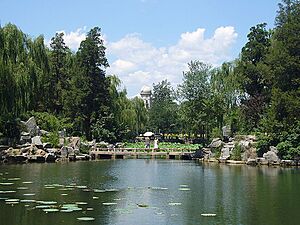
How Tsinghua University Started (1911–1949)
Tsinghua University was created in Beijing during a difficult time in China's history. There were many conflicts with other countries. After a major uprising called the Boxer Rebellion, China had to pay money to several foreign countries. The United States decided that the amount of money it was supposed to receive was too much.
So, in 1909, the U.S. government agreed to use some of this money for scholarships. These scholarships would help Chinese students study in the United States.
Using these funds, Tsinghua College was opened on April 29, 1911. It was built on the site of a former royal garden in Beijing. The college was a special school to prepare students to study in America. Teachers for science subjects came from the United States. Students who graduated from Tsinghua could go directly to American universities.
In 1925, Tsinghua College started offering its own four-year university programs. It also began a research center for Chinese studies. In 1928, the school officially changed its name to National Tsinghua University.
During the Second Sino-Japanese War, many Chinese universities had to move to safer places. In 1937, Tsinghua University joined with Peking University and Nankai University. They formed the Changsha Temporary University in Changsha, Hunan. Later, this merged university became the National Southwestern Associated University in Kunming, Yunnan. After World War II ended, the Tsinghua part of the university returned to Beijing.
Tsinghua After 1949
After the Chinese Civil War ended in 1949, China's government changed. The president of Tsinghua University at the time, Mei Yi-chi, and many professors moved to Taiwan. There, they started a new school in 1955, which later became the National Tsing Hua University. This university in Taiwan is separate from Tsinghua University in Beijing.
In 1952, the Chinese government reorganized many universities. Tsinghua University became a special school focused mainly on engineering and natural sciences.
In the 1980s, Tsinghua University began to offer more than just engineering. It brought back many different subjects and schools. This included the Tsinghua Law School, the School of Economics and Management, and schools for sciences and humanities.
In 1996, the School of Economics and Management started working with the Sloan School of Management at the Massachusetts Institute of Technology (MIT). A year later, they launched a joint MBA program. In 1998, Tsinghua became the first Chinese university to offer a Master of Laws (LLM) program in American law.
Tsinghua in the 21st Century
Many important leaders in China have graduated from Tsinghua University. These include Xi Jinping, the current leader of China, and Hu Jintao, a former leader. Tsinghua also invites famous international speakers, like Bill Clinton and Tony Blair, to give talks.
As of 2018, Tsinghua University has 20 schools and 58 departments. It also has many research institutes and laboratories. In 2006, the famous Peking Union Medical College became "Peking Union Medical College, Tsinghua University." They are still separate but work closely together.
Tsinghua University offers many different degree programs. These include over 82 bachelor's degrees, 80 master's degrees, and 90 PhD programs.
In 2014, Tsinghua started Xinya College. This college helps students explore different subjects before choosing a major. It is similar to how some universities in the United States and Europe work.
In 2016, the Schwarzman Scholars program was created. It offers a special one-year master's degree for future global leaders. Students from around the world live and study at Schwarzman College on the Tsinghua campus.
In 2024, Tsinghua announced a change in its leadership structure. The university president's office joined with the university's Communist Party committee. This means the Party committee now directly manages the university.
What Students Learn and Research
Tsinghua University offers a wide range of subjects. These include science, engineering, arts, social sciences, law, and medicine. It has 20 colleges and 57 departments. Tsinghua is part of many international university groups, like the Association of Pacific Rim Universities.
How to Get In
Getting into Tsinghua University is very difficult because it is so popular. For Chinese students, undergraduate admission is based on the gaokao, which is China's national college entrance exam. Very few students who take this exam get into Tsinghua.
Admission to Tsinghua's graduate programs is also very competitive. For example, only about 16% of students who apply for the MBA program are accepted each year.
Research at Tsinghua
Tsinghua University does a lot of research. Most of this research is supported by money from the government. Each year, the university works on more than 1,400 projects in science and technology.
In 2007, Tsinghua was approved to do secret research for military purposes. The university also hosts a special summer program on intellectual property with Franklin Pierce Law Center.
Tsinghua University has many research centers. Some are approved by the government, some are set up by the university itself, and some are joint projects with other organizations. As of December 31, 2022, Tsinghua had 428 active research institutions.
University Rankings
Tsinghua University is consistently ranked as one of the top universities in China and Asia. It is also highly ranked globally.
- The Times Higher Education ranked Tsinghua No. 1 in China and Asia-Oceania. It was also ranked 8th globally for its reputation.
- The World's Universities with Real Impact (WURI) ranked Tsinghua 10th among global innovative universities in 2020.
- The QS World University Rankings placed Tsinghua 15th in the world in 2020. It was also ranked 6th globally for how well its graduates find jobs.
- The "Shanghai Ranking" (Academic Ranking of World Universities) placed Tsinghua 22nd in the world and 1st in Asia & Oceania in 2023.
- U.S. News & World Report ranked Tsinghua 1st in Asia-Pacific and 11th globally in its 2025-2026 Best Global Universities Rankings.
Research Performance Rankings
Tsinghua is also recognized for its strong research.
- In 2024, it ranked 3rd globally by SCImago Institutions Rankings.
- The Nature Index 2025 Annual Tables ranked Tsinghua 6th among top universities for high-quality research in natural science.
- The 2024 CWTS Leiden Ranking placed Tsinghua University 3rd in the world for its scientific publications.
- In November 2024, Clarivate Analytics ranked Tsinghua 4th globally for having the most cited researchers.
Subject Rankings
Tsinghua University is especially strong in certain subjects.
- Since 2015, U.S. News & World Report has ranked Tsinghua University as the top global university for Engineering.
- As of 2024, it also ranked number one globally in 9 subjects: "Artificial Intelligence", "Chemical Engineering", "Chemistry", "Computer Science", "Energy and Fuels", "Engineering", "Environment Engineering", "Environment/Ecology" and "Material Science".
- Many other subjects at Tsinghua are ranked in the global Top 10 by U.S. News & World Report.
Departments and Schools
Tsinghua University has many different schools and departments. Here are some of them:
- Humanities: Chinese Language and Literature, Philosophy, History, Foreign Languages and Literatures, History of Science.
- Social Sciences: Sociology, Psychology, Political Science, International Relations, Institute of Economics.
- Economics and Management: Accounting, Economics, Finance, Marketing, Management Science and Engineering.
- Information Science and Technology: Electronic Engineering, Microelectronics and Nanoelectronics, Computer Science and Technology, Software, Automation.
- Academy of Arts and Design: Art History, Industrial Design, Environmental Art Design, Ceramic Design, Visual Communication Design, Textile and Fashion Design, Painting, Sculpture.
- Sciences: Mathematical Sciences, Physics, Chemistry, Earth System Science.
- Civil Engineering: Civil Engineering, Construction Management, Hydraulic Engineering.
- Environment: Environmental Engineering, Environmental Sciences, Environmental Planning and Management.
- Aerospace Engineering: Aeronautical and Astronautical Engineering, Engineering Mechanics.
- Mechanical Engineering: Mechanical Engineering, Precision Instrument, Automotive Engineering, Industrial Engineering.
- Medicine: Basic Medical Sciences, Biomedical Engineering, Clinical Medicine, Public Health.
- Architecture: Architecture, Urban Planning and Design, Building Science, Landscape Architecture.
- Other schools include Journalism and Communication, Law, Electrical Engineering, Public Policy and Management, Materials Science and Engineering, Life Sciences, Engineering Physics, Chemical Engineering, and Marxism.
Department of Industrial Engineering
The Department of Industrial Engineering at Tsinghua (Tsinghua IE) has three main areas of study:
- Operations Research & Data Science
- System Operation and Digital Management
- Human Factors and Human-System Interaction
They also have special centers that work with other organizations:
- Institute of Quality and Reliability
- Institute of Industrial Culture
- Center for Smart Logistics and Supply Chain Management
Department of Mathematical Sciences
The Department of Mathematical Sciences (DMS) was first created in 1927. In 1952, it joined with Peking University's math department. It was later re-established at Tsinghua and got its current name in 1999.
Today, Tsinghua DMS has three institutes: Pure Mathematics, Applied Mathematics and Probability and Statistics, and Computational Mathematics and Operations Research. It has about 400 undergraduate students and 200 graduate students.
Department of Precision Instrument
The Department of Precision Instrument focuses on making very accurate tools and machines. Its goal is to help national development and improve people's lives.
Research in Precision Instrument
Research in this department is done through four main institutes:
- The Institute of Opto-electronic Engineering (IOEE): This institute works on light-based instruments, precise measurements, and modern optical information.
- The Institute of Instrument Science and Technology: This is a very important institute for precise measuring technology.
- The Engineering Research Center for Navigation Technology: This center focuses on highly accurate navigation tools and tiny sensors called MEMS.
- The Center for Photonics and Electronics: This center develops advanced laser and light technology.
The department also has several key laboratories and national engineering research centers.
Education in Precision Instrument
The Department of Precision Instrument offers two main study areas: instrumental science and technology, and optical engineering.
It has six teaching labs and centers that help students learn. These include labs for manufacturing, computer-aided design (CAD), engineering graphics, and measurement and control technology. The department offers over 40 courses for undergraduate students and 25 for graduate students.
School of Life Sciences
The School of Life Sciences started as the Department of Biology in 1926. A famous botanist, Qian Chongshu, was its first dean.
In the 1950s, the Department of Biology was merged into other universities. For almost 30 years, Tsinghua did not have a biology department.
In 1984, the Department of Biology was re-established and officially reopened. It received a lot of help from other universities and scientists. In 2009, it changed its name to the School of Life Sciences. As of 2013, Dr. Wang Hongwei was the dean. The school has 129 professors and staff, and about 600 undergraduate students.
Peking Union Medical College
The Peking Union Medical College was founded in 1917 by the Rockefeller Foundation. It was designed like medical schools in the U.S. Tsinghua started its own medical school in 2001. In 2006, Tsinghua's medical school joined with Peking Union Medical College. It was then renamed "Peking Union Medical College, Tsinghua University."
This school is considered the top medical school and hospital in China. It is also the only medical school connected to the Chinese Academy of Medical Sciences. It has a very competitive 8-year MD program. Students spend 2.5 years at Tsinghua for pre-medical studies. Then they move to Peking Union Medical College for 5.5 years of clinical medicine and research.
School of Economics and Management
The School of Economics and Management has a long history, going back to 1926. That's when Tsinghua University first created its Faculty of Economics.
School of Journalism and Communication
The Tsinghua School of Journalism and Communication (TSJC) was established in April 2002. It grew from the Communication Studies program. The school focuses on areas like International Communication, Film and Television, New Media, and Media Management. It aims to train talented professionals in journalism and communication.
The school also offers a two-year graduate program in international business journalism. This program is supported by Bloomberg L.P. and the International Center for Journalists (ICFJ). It trains students and media professionals from around the world in financial media.
The school has five research centers. These centers organize and conduct academic research. They include centers for International Communications, New Media, Film and Television, Media Management, and Cultural Industry Studies.
School of Law
Legal studies at Tsinghua University began very early, even before it was called a university. Many students from "Tsinghua College" (1911–1929) went to study law in Western countries. These graduates became important in law and diplomacy.
The Tsinghua University School of Law was officially established in 1929. It focused on international affairs and Chinese law. In 1952, the law school was closed as Tsinghua became an engineering-focused university. Law courses were still taught, but a formal law school didn't exist until 1995.
On September 8, 1995, the Department of Law was re-established. On April 25, 1999, it became the "School of Law." The new law school has continued to focus on international law. Because of its excellent teachers and students, Tsinghua University School of Law is now one of the top law schools in China. Since 2011, it has been consistently ranked as one of the best in mainland China by QS World University Rankings.
Graduate School at Shenzhen
The Graduate School at Shenzhen was created by Tsinghua University and the Shenzhen city government. It is directly connected to Tsinghua University in Beijing. The campus opened in Shenzhen on October 18, 2003.
This school aims to train top professionals and develop new scientific and technological ideas. It has several academic divisions, including:
- Life Science and Health
- Energy and Environment
- Information Science and Technology
- Logistics and Transportation
- Advanced Manufacturing
- Social Sciences and Management
- Ocean Science and Technology
Campus Life and Buildings
Tsinghua University's campus is in northwest Beijing, in the Haidian district. In 2010, Forbes magazine named Tsinghua University's campus one of the most beautiful in the world. It was the only university in Asia on that list.
Many architects helped design the buildings on campus. American architect Henry Killam Murphy designed the Grand Auditorium and the Science Building. Chinese architects like Yang Tingbao and Shen Liyuan also designed important buildings. The campus has a mix of traditional Chinese and Western architectural styles.
The university also has its own Tsinghua History Museum. This museum shows the history of Tsinghua University through old documents, pictures, and videos. There is also the Tsinghua University Art Museum, which displays art from the university's Academy of Arts & Design.
Famous People from Tsinghua
Notable Alumni
Tsinghua University has many famous graduates. They have become important leaders in politics, academics, and business. Forbes magazine has even called Tsinghua China's "power factory." This is because so many senior Chinese politicians have graduated from there.
Some famous alumni in Chinese politics include:
- Xi Jinping, the current leader of China.
- Hu Jintao, a former leader of China.
- Zhu Rongji, a former premier of China.
- Other politicians like Wu Bangguo and Huang Ju.
Tsinghua graduates are also very successful in science. Some notable scientists include:
- Yang Chen Ning, a Nobel Prize winner in Physics.
- Shiing-Shen Chern, a mathematician who won the Wolf Prize.
- Biologist Min Chueh Chang.
- Theoretical physicist Zhou Peiyuan.
Tsinghua is known for educating many billionaires in China. As of 2017, 152 billionaires were Tsinghua alumni. These include people like Sun Hongbin (real estate) and Jiang Bin (components).
In the arts and literature, famous alumni include:
- Author Qian Zhongshu.
- Poet Wen Yiduo.
- Historian and poet Wang Guowei.
Tsinghua Group
The term "Tsinghua group" refers to a group of Chinese politicians who graduated from Tsinghua University. They are part of a newer generation of Chinese leaders. Many of them studied in the United States after graduating from Tsinghua. Some believe they support ideas for reform and more open government. Their rise to power began around 2008.
Images for kids
See also
 In Spanish: Universidad Tsinghua para niños
In Spanish: Universidad Tsinghua para niños
- Tsinghua Shenzhen International Graduate School
- Peking Union Medical College
- National Tsing Hua University
- Tsinghua clique
- Tsinghua University Press
- Education in the People's Republic of China
- Tsinghua University High School


